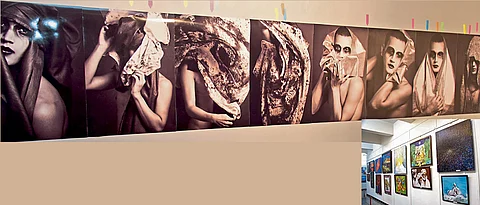

Thanks to its extra-curricular tag, art has always been a secondary consideration in India. People in the field shed light on the art scene in India
ST Correspondent
features@sakaaltimes.com
From paintings to sculptures, art has always been an integral part of our culture for centuries. And why not? Man began communicating through art even before languages were discovered.
Natural colours made from leaves, turmeric, soil and paintings made using twigs and animal hair to creating digital art —we have come a long way. Painting styles have evolved and new techniques continue to crop up with the advent of technology and education.
What hasn’t changed over the decades is man’s passion for art. Is that enough to sustain art as a commerce though? Probably not. “Sustaining an art gallery is still not an easy thing to accomplish,” says Varsha Munot, founder-director of city-based Renaissance Art Gallery.
Is that owing to the lack of art awareness among masses? Delhi Art Gallery (DAG) president Kishore Singh, who was recently in town for an exhibition, is of the opinion that most Indians don’t know how to look at art. “We cannot say with conviction that a particular piece of art is bad, or that it is good for a specific reason. We don’t yet know how to discuss artwork. That’s what I want to initiate. We need to learn to talk art,” he says.
Munot, however, begs to differ. “Knowledge of art is no more scarce in India. The kind of awareness among people these days is notable. Also, schools and universities are playing a vital role in imparting art knowledge. Especially noteworthy are schools — every board of education is now including art in the curriculum in a more meaningful way,” she insists.
Speaking of Pune, city-based art connoisseur and architect Alpana Kirloskar, at an event recently, had said that she sees a huge gap in terms of art awareness between cities. “Pune doesn’t have enough exposure to art as opposed to Delhi. This city is big on theatre and culture, but needs to pick up on the art side,” she believes.
Also, art is a broad subject. From paintings to doodles, sculptures, home decor and street art — it is all-encompassing. “Architects and interior decorators too are contributing to the promotion of art when they design a home and leave their mark. Street art too, for that matter is gaining much popularity with projects like the Smart City,” says the optimist Munot, while agreeing that sustainability of galleries remains a tough terrain.
“Art, we believe, is directly proportional to the markets. When the markets are doing well, art investment sees a rise since it is a luxury and not a necessity. So people invest only when they are financially prosperous,” Munot says.
She also credits the media — traditional and online, for the attention that art is beginning to garner. While art galleries often wear a deserted look, it does attract a knowledgeable lot too. “I have observed so many guests coming here with not only interest but knowledge of the art form. They often ask for more information about an artist or his piece of work,” she asserts.
Shirish Deshpande, a renowned artist, who paints using different shades of ball pens, says, “It is important for people to explore different art forms and appreciate them in the right way. They should ensure that they have enough knowledge on how the artist has worked and value it accordingly. Government organisations too should take an initiative to provide a platform to the artists and for people to know about the different techniques used by artists. Art is a part of us; a child starts scribbling and drawing lines even before talking.”
Speaking of measures that can be taken to promote art, Deepti Toke, a non-professional artist, says, “In the West, art is taught from a very young age. In India, parents and teachers focus more on academic subjects. Children are thus discouraged when it comes to art.”
A number of art-based visits are, however, now becoming frequent with schools, Munot points out. She gives the example of school trips to places like Mumbai’s Kala Ghoda festival. “This will eventually mean a hike in the footfall at art galleries too,” she believes.
(Inputs by Sayali Duraphe)
